Buddha Images in the U Thong style
U Thong art flourished in Central Thailand between the 12-15th century A.D. in the period when Khmer influence was diminishing or disappearing and before and during the early stages of the Ayutthaya Kingdom. As such U Thong style was influenced by previous and contemporary styles in the region.
Depending on prevailing influences and the time frame, U Thong Buddha images are often subdivided into three groups.
Typical of U Thong Buddha images is a small band between the hairline and the forehead. The head features small curls. The face of the Buddha image is rather square with Mon and Khmer characteristics. During the early period the ushnisha (prominent bump on the top of Buddha's head) is topped by a lotus bud. In later period (Sukhothai influence), this is replaced by an elongated flame. The face became more oval later on, and the body more elongate under the influence of the Sukhothai style.
The eyes are cast (not inlaid as often the case with images of the Ayutthaya period).
The robe is draped in the open mode with a long flap over the left shoulder (see image below) ending above the navel.
U Thong style Buddha images mostly display the gesture of Subduing Mara in the sitting position, and the gesture of Dispelling Fear (Abhaya Mudra) in the standing position.
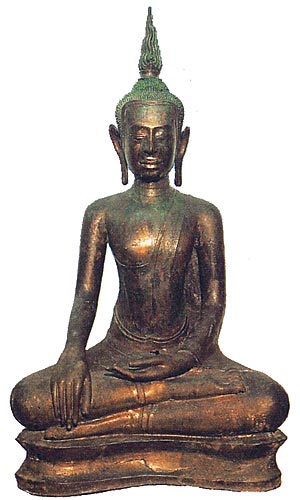
2nd period of U-Thong Style, 15th Century
From Wat Mahathat ,Sukhothai
Presently at Ramkhamhaeng National Museum, Sukhothai.
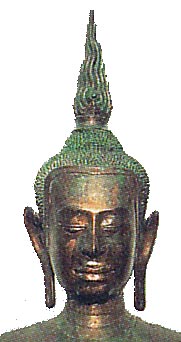
2nd period of U-Thong Style, 15th Century. Notice the band between the hairline and the forehead.
From Wat Mahathat ,Sukhothai
Presently at Ramkhamhaeng National Museum, Sukhothai.
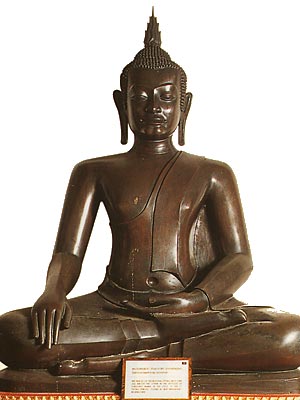
In the style of the U-Thong period.
Found at Wat Mahathat, Muang San, Chainat province.
Image present in the cloister of the Ubosoth at Wat Benchamabophit, Bangkok.

National Museum Prachinburi.
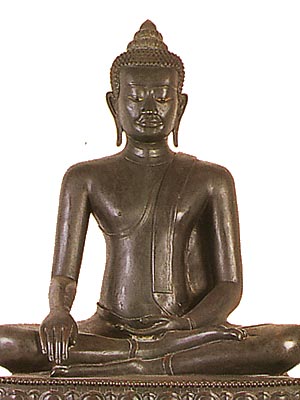
In the style of the U-Thong period.
Cast and enlarged from an ancient model.
Image present in the cloister of the Ubosoth at Wat Benchamabophit, Bangkok.
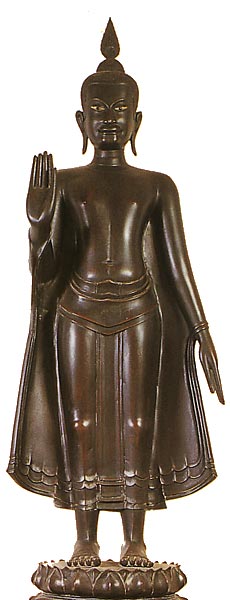
In the style of the U-Thong period.
Cast from a model at Wat Rajathiwat, Bangkok
Image present in the cloister of the Ubosoth at Wat Benchamabophit, Bangkok.

In the style of the U-Thong period.
Found at Wat Ratchathani, Sukhothai province.
Image present in the cloister of the Ubosoth at Wat Benchamabophit, Bangkok.

National Museum Prachinburi.
![]() Characteristics and Postures of the Buddha
Characteristics and Postures of the Buddha
![]() Sitting Buddhas
Sitting Buddhas
![]() Reclining Buddhas
Reclining Buddhas
![]() Seven Days of the Buddha
Seven Days of the Buddha
Hand Gestures :
![]() The Six Main Mudras
The Six Main Mudras
![]() Dhyana Mudra
Dhyana Mudra
![]() Bhumisparsha Mudra
Bhumisparsha Mudra
![]() Abhaya Mudra
Abhaya Mudra
![]() Vitarka Mudra
Vitarka Mudra
![]() Varada Mudra
Varada Mudra
Historical Periods :
![]() Dvaravati
Dvaravati
![]() Khmer-Lopburi
Khmer-Lopburi
![]() Chiang Saen - Lanna
Chiang Saen - Lanna
![]() Sukhothai
Sukhothai
![]() U Thong
U Thong
![]() Ayutthaya
Ayutthaya
Historical Notes :
![]() Dvaravati
Dvaravati
![]() Sukhothai
Sukhothai
![]() Ayutthaya
Ayutthaya
![]() Resources
Resources
Temples in Thailand :
![]() Overview
Overview
![]() Wat Pho
Wat Pho
![]() Wat Benchamabophit
Wat Benchamabophit
Buddha Images at :
![]() Buddha Images at Wat Phra Pathom Chedi
Buddha Images at Wat Phra Pathom Chedi
![]() Introduction to Buddhism in Thailand
Introduction to Buddhism in Thailand
![]() The 10 Jatakas (lives of the Buddha) as depicted in Thai mural Temple paintings
The 10 Jatakas (lives of the Buddha) as depicted in Thai mural Temple paintings
More about Thailand at ThaiWebsites.com : Articles, and Web Directory
Content by Guido Vanhaleweyk, Bangkok.

.png)